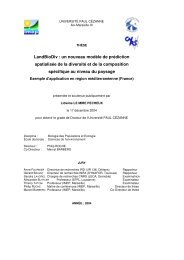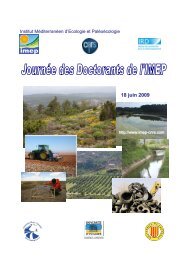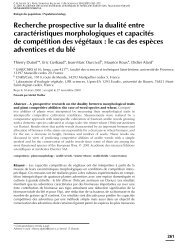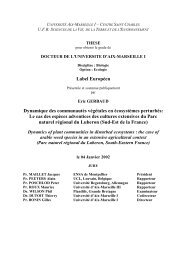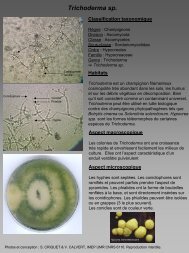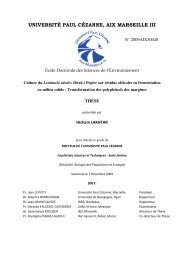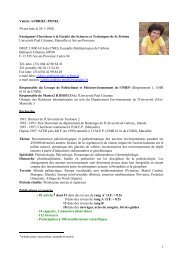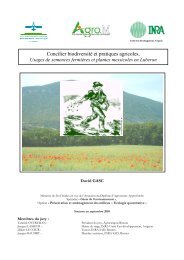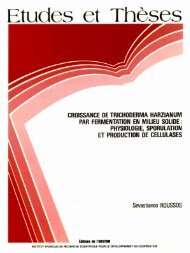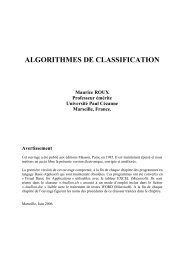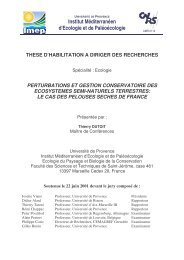Veget Hist Archaeobotboth warm temperatures with seasonal drying and alsoincreased input of minerogenic sediments via fluvial systems(e.g. Carrión and Navarro 2002). In <strong>the</strong> Black Sea, it has beenfound in <strong>the</strong> late <strong>Holocene</strong> layers, while in <strong>the</strong> <strong>early</strong> <strong>Holocene</strong>brackish waters of <strong>the</strong> same basin it has not been found(Mudie et al. 2011). This may suggest a link with increasedanthropogenic activities in <strong>the</strong> Black Sea drainage basin. Itsincrease in <strong>the</strong> Burmarrad palaeo-estuarine environmentmay thus be better interpreted as being related <strong>to</strong> a slightincrease in soil erosion due <strong>to</strong> human activities in accordancewith o<strong>the</strong>r anthropogenic indica<strong>to</strong>rs.ConclusionsThe main trends of vegetation change in NW Malta <strong>during</strong><strong>the</strong> <strong>early</strong> <strong>to</strong> <strong>mid</strong>-<strong>Holocene</strong> transition were similar <strong>to</strong> o<strong>the</strong>rregional vegetation records from <strong>the</strong> south-central Mediterraneanregion, especially those of coastal Sicily characterizedby <strong>the</strong> transformation of a steppe-like vegetation/garrigue in<strong>to</strong> a dense shrubland/maquis dominated byevergreen Pistacia. Differences in <strong>the</strong> vegetation <strong>dynamics</strong>seem <strong>to</strong> be mostly linked <strong>to</strong> <strong>the</strong> different phy<strong>to</strong>geographicaland floristic contexts of Malta in relation <strong>to</strong> neighboringareas. The ca. 2,000-year pollen record presented in thisstudy shows that <strong>the</strong> potential natural vegetation of <strong>the</strong>Maltese islands in <strong>the</strong> absence of human pressure is notnecessarily an evergreen oak forest dominated by Quercusilex, but can be a Mediterranean evergreen shrubland orsmall woodland comprising Pistacia cf. lentiscus and mostprobably o<strong>the</strong>r insect-pollinated trees and shrubs not representedin <strong>the</strong> pollen assemblages (e.g. Cera<strong>to</strong>nia siliqua).Malta and Sicily are located at a key climatic point in <strong>the</strong>central Mediterranean because <strong>the</strong> <strong>Holocene</strong> climatic his<strong>to</strong>ryshows different palaeohydrological patterns, <strong>to</strong> <strong>the</strong> north andsouth of <strong>the</strong>ir latitudinal position. Their different vegetationand hydrological <strong>dynamics</strong> may reflect a stronger effect of<strong>the</strong> streng<strong>the</strong>ned subtropical monsoon systems <strong>during</strong> periodsof <strong>the</strong> Nor<strong>the</strong>rn Hemisphere boreal solar insolationmaxima. Although <strong>the</strong> traces of human activities in <strong>the</strong>studied area are evident from <strong>the</strong> beginning of <strong>the</strong> diagram atca. 7350 cal. B.P./5350 B.C., human presence has becomemore evident since <strong>the</strong> beginning of <strong>the</strong> Temple culturalphase at ca. 6050 cal. B.P./4100 B.C. through a conspicuousreduction in tree pollen and increasing values of anthropogenicpollen indica<strong>to</strong>rs of overgrazing and soil erosion. Aswith coastal Sicily, we suggest that <strong>the</strong> <strong>early</strong>- <strong>to</strong> <strong>mid</strong>-<strong>Holocene</strong>vegetation transformation was mainly controlled by aregional climatic change that occurred in a landscape onlyslightly impacted by human activities.Acknowledgments This study was supported by <strong>the</strong> PALEOMEDproject (ANR 09-BLAN-0323-204 01) financed by <strong>the</strong> FrenchNational Research Agency. The first author wishes <strong>to</strong> thank LaurentLondeix, Maria Sanchez Goñi, Jean-Louis Turon, and FrédériqueEynaud from EPOC, for <strong>the</strong>ir hospitality and valuable advice ondinoflagellate identification and scientific discussions <strong>during</strong> hisresearch stay at <strong>the</strong> University of Bordeaux in January 2011. We arealso thankful <strong>to</strong> Willy Tinner for his invaluable comments on <strong>the</strong>BM1 pollen diagram and Arne Saatkamp for his assistance withbotanical interpretation of <strong>the</strong> diagram. Constructive and thoughtfulcomments of <strong>the</strong> two reviewers of this paper are greatly appreciated.ReferencesAuguier J (1966) Flore des bryophytes. Lechevalier, ParisBen Tiba B, Reille M (1982) Recherches pollenanalytiques dans lesmontagnes de Kroumirie (Tunisie septentrionale): premiersrésultats. Ecol Mediterr 8:75–86Benslama M, Andrieu-Ponel V, Guiter F, Reille M, Migliore J, deBeaulieu J-L, Djamali M (2010) Nouvelles contributions àl’his<strong>to</strong>ire tardiglaciaire et holocène de la végétation en Algérie:analyses polliniques de deux profils sédimentaires du complexehu<strong>mid</strong>e d’El-Kala. CR Biol 333:744–754Beug H-J (2004) Leitfaden der Pollenbestimmung für Mitteleuropaund angrenzende Gebiete. Pfeil, MünchenBlaauw M (2010) Methods and code for ‘classical’ age-modelling ofradiocarbon sequences. Quat Geochronol 5:512–518Blouet B (2007) The s<strong>to</strong>ry of Malta, revised edn. Allied Publications,MaltaBonanno A (2005) Malta, Phoenician, Punic and Roman. MidseaBooks Ltd., MaltaBrodersen KP, Lindegaard C (1999) Classification, assessment andtrophic reconstruction of Danish lakes using chirono<strong>mid</strong>s.Freshw Biol 42:143–157Brodersen KP, Odgaard BV, Vestergaard O, Anderson NJ (2001)Chirono<strong>mid</strong> stratigraphy in <strong>the</strong> shallow and eutrophic LakeSobygaard, Denmark: chirono<strong>mid</strong>-macrophyte co-occurrence.Freshw Biol 46:253–267Brodin YW (1986) The postglacial his<strong>to</strong>ry of Lake Flarken, sou<strong>the</strong>rnSweden; interpreted from subfossil insect remains. Internat RevGesamt Hydrobiol 71:371–432Brooks SJ, Birks HJB (2001) Chirono<strong>mid</strong>-inferred air temperaturesfrom late-glacial and <strong>Holocene</strong> sites in north-west Europe:progress and problems. Quat Sci Rev 20:1,723–1,741Brooks SJ, Langdon PG, Heiri O (2007) The identification and use ofpalaearctic chirono<strong>mid</strong>ae larvae in palaeoecology. QRA TechnicalGuide No 10. Quat Res Ass, LondonBuskens RFM (1987) The chirono<strong>mid</strong> assemblages in shallow lenticwaters differing in acidity, buffering capacity and trophic levelin <strong>the</strong> Ne<strong>the</strong>rlands. En<strong>to</strong>mol Scand Suppl 29:217–224Calò C, Henne PD, Curry B, Magny M, Vescovi E, La Mantia T,Pasta S, Vannière B, Tinner W (2012) Spatio-temporal patternsof <strong>Holocene</strong> environmental change in sou<strong>the</strong>rn Sicily. PalaeogeogrPalaeoclima<strong>to</strong>l Palaeoecol 323–325:110–122Carrión JS, Navarro C (2002) Cryp<strong>to</strong>gam spores and o<strong>the</strong>r non-pollenmicrofossils as sources of palaeoecological information: casestudiesfrom Spain. Annal Bot Fin 39:1–14Cassar C (2000) A concise his<strong>to</strong>ry of Malta, 2nd edn. MiveraPublications Ltd., MaltaCassar LF, Conrad E, Schembri PJ (2007) The Maltese Archipelago.In: Vogiatzakis IN, Pungetti GA, Manion M (eds) Mediterraneanisland landscapes. Landscape series No 9, pp 297–322Cugny C (2011) Apports des microfossiles non-polliniques à l’his<strong>to</strong>iredu pas<strong>to</strong>ralisme sur le versant nord Pyrénéen entreréférentiels actuels et reconstitution du passé. PhD <strong>the</strong>sis,Université Toulouse 2 Le Mirail123
Veget Hist ArchaeobotDíaz Lifante Z, Valdés B (1994) Lec<strong>to</strong>typification of Asphodelusramosus (Asphodelaceae), a misunders<strong>to</strong>od Linnaean name.Taxon 43:245–251Djamali M, Akhani H, Andrieu-Ponel V, Bracconnot P, Brewer S, deBeaulieu J-L, Fleitmann D, Fleury J, Gasse F, Guibal F, JacksonST, Lézine A-M, Médail M, Ponel P, Roberts N, Stevens L(2010) Indian Summer Monsoon variations could have affected<strong>the</strong> <strong>early</strong> <strong>Holocene</strong> woodland expansion in <strong>the</strong> Near East.<strong>Holocene</strong> 20:813–820Drescher-Schneider R, de Beaulieu J-L, Magny M, Walter-SimonnetAV, Bossuet G, Millet L et al (2007) <strong>Vegetation</strong> his<strong>to</strong>ry, climateand human impact over <strong>the</strong> last 15 000 years at Lago dell’Accesa(Tuscany, Central Italy). Veget Hist Archaeobot 16:279–299Emeis K-C (2007) Sapropels. In: Gornitz V (ed) Encyclopedia ofclima<strong>to</strong>logy and ancient environments. Encyclopaedia of earthsciences series, part 18, pp 876–877Fenech K (2007) Human induced changes in <strong>the</strong> environment andlandscape of <strong>the</strong> Maltese Islands from <strong>the</strong> Neolithic <strong>to</strong> <strong>the</strong> 15thcentury AD. BAR Internat Ser 1,682, OxfordFleitmann D, Burns SJ, Mangini A, Mudlesee M, Kramers J, Villa I, NeffU, Al-Subbary AA, Buettner A, Hippler D, Matter A (2007)<strong>Holocene</strong> ITCZ and Indian monsoon <strong>dynamics</strong> recorded in stalagmitesfrom Oman and Yemen (Socotra). Quat Sci Rev 26:170–188Gambin T (2005) The maritime landscapes of Malta from <strong>the</strong> Romanperiod <strong>to</strong> <strong>the</strong> Middle Ages. Unpublished PhD <strong>the</strong>sis, Universityof Bris<strong>to</strong>l, Bris<strong>to</strong>lGandouin E, Maasri A, Van Vliet-Lanoë B, Franquet E (2006)Chirono<strong>mid</strong> (Insecta: Diptera) assemblages from a gradient oflotic and lentic waterbodies in river floodplains of France: amethodological <strong>to</strong>ol for palaeoecological applications. J Paleolimnol35:149–166Gandouin E, Ponel P, Andrieu-Ponel V, Guiter F, de Beaulieu J-L,Djamali M, Franquet E, van Vliet-Lanoë B, Alvitre M, MeurisseM, Brocandel M, Brulhet J (2009) 10,000 years of vegetationhis<strong>to</strong>ry of <strong>the</strong> Aa palaeoestuary, St-Omer Basin, nor<strong>the</strong>rn France.Rev Palaeobot Palynol 156:307–318García-Fayos P, Verdú M (1998) Soil seed bank, fac<strong>to</strong>rs controllinggermination and establishment of a Mediterranean shrub:Pistacia lentiscus L. Acta Oecol 19:357–366Grech CF (2001) A forest his<strong>to</strong>ry of <strong>the</strong> Maltese islands <strong>to</strong> AD 1800.Unpublished PhD <strong>the</strong>sis, University of Aberdeen, AberdeenGrimm EC (1987) Coniss: a Fortran 77 program for stratigraphicallyconstrained cluster analysis by <strong>the</strong> method of incremental sum ofsquares. Comput Geosci 13:13–35Grimm EC (2004–2005) TILIA and TGView software, version 2.0.2.Illinois State University, Springfield, USAGrove AT, Rackham O (2001) The nature of Mediterranean Europe;an ecological his<strong>to</strong>ry. Yale University Press, LondonHaas J-N (1996) Palaeoecological indica<strong>to</strong>rs found in pollen preparationsfrom <strong>Holocene</strong> freshwater lake sediments. Rev PalaeobotPalynol 91:371–382Haslam SM, Sell PD, Wolseley PA (1977) A flora of <strong>the</strong> MalteseIslands. Malta University Press, MsidaHeiri O, Lotter AF (2001) Effect of low count sums on quantitativeenvironmental reconstruction: an example using subfossil chirono<strong>mid</strong>s.J Paleolimnol 26:343–350Hofmann W (1984) Stratigraphie subfossiler Cladocera (Crustacea)und Chirono<strong>mid</strong>ae (Diptera) in zwei Sedimentprofilen desMeerfelder Maares. Cour Forsch-Inst Senckenberg 65:67–80Hunt CO (1997) Quaternary deposits in <strong>the</strong> Maltese Islands: amicrocosm of environmental change in Mediterranean lands.Geo J 41:101–109Hunt CO, Schembri PJ (1997) Quaternary environments and biogeographyof <strong>the</strong> Maltese Islands. In: Mifsud A, Savona Ventura C(eds) Facets of Maltese prehis<strong>to</strong>ry. The Prehis<strong>to</strong>ric Society ofMalta, Malta, pp 41–75Hunt CO, Brooks I, Meneely J, Brown D, Buzaian A, Barker G (2011)The Cyrenaican Prehis<strong>to</strong>ry Project 2011: Late-<strong>Holocene</strong> environmentsand human activity from a cave fill in Cyrenaica,Libya. Libyan Stud 42:77–87Incarbona A, Di Stefano E, Patti B, Pelosi N, Bonomo S, Mazzola S,Sprovieri R, Tranchida G, Zgozi S, Bonnano A (2008) <strong>Holocene</strong>millennial-scale variations in <strong>the</strong> Sicily Channel (MediterraneanSea). Paleoceanogr 23:PA3204Jordano P (1988) Polinización y variabilidad de la producción desemillas en Pistacia lentiscus L. (Anacardiaceae). Anales delJardín Botánico de Madrid 45:213–231Jordano P (1989) Pre-dispersal biology of Pistacia lentiscus (Anacardiaceae):cumulative effects on seed removal by birds. Oikos55:375–386Klink AG (2002) Determineersleutel voor de larven van de inNederland voorkomende soorten Polypedilum. Concept uitgaveSTOWA 06Klink AG, Moller Pillot HKM (2003) Chirono<strong>mid</strong>ae larvae. Key <strong>to</strong> <strong>the</strong>higher taxa and species of <strong>the</strong> lowlands of Northwestern Europe.World Biodiversity Database CD-ROM series. Expert Center forTaxonomic Identification, University of Amsterdam, AmsterdamLanfranco E (1995) The vegetation of <strong>the</strong> Maltese Islands. In: GiustiF, Manganelli G, Schembri PJ (eds) The non-marine molluscs of<strong>the</strong> Maltese Islands. Museo Regionale di Scienze Naturali,Torino, pp 27–29Larcher W (2000) Temperature stress and survival ability ofMediterranean sclerophyllous plants. Plant Biosyst 134:279–295Magny M, Vannière B, de Beaulieu J-L, Bégeot C, Heiri O, Millet Oet al (2007) <strong>Holocene</strong> climate changes in <strong>the</strong> central Mediterraneanas recorded by lake-level fluctuations at Lake Accesa(Tuscany, Italy). Quat Sci Rev 26:1,951–1,964Magny M, Vannière B, Calo C, Millet L, Leroux A, Peyron O,Zanchetta G, La Mantia T, Tinner W (2011) <strong>Holocene</strong> hydrologicalchanges in south-western Mediterranean as recorded bylake-level fluctuations at Lago Preola, a coastal lake in sou<strong>the</strong>rnSicily, Italy. Quat Sci Rev 30:2,459–2,475Magny M, Peyron O, Sadori L, Ortu E, Zanchetta G, Vannière B,Tinner W (2012) Contrasting patterns of precipitation seasonality<strong>during</strong> <strong>the</strong> <strong>Holocene</strong> in <strong>the</strong> south- and north-central Mediterranean.J Quat Sci 27:290–296Magri D, Sadori L (1999) Late Pleis<strong>to</strong>cene and <strong>Holocene</strong> pollenstratigraphy at Lago di Vico, central Italy. Veget Hist Archaeobot8:247–260Malone C, S<strong>to</strong>ddart S, Trump D, Bonanno A, Gouder T, Pace A(2009) Mortuary cus<strong>to</strong>ms in prehis<strong>to</strong>ric Malta: Excavations at<strong>the</strong> Broch<strong>to</strong>rff Circle at Xaghra, Gozo (1987–1994). McDonaldInstitute Monographs, McDonald Institute for ArchaeologicalResearch, CambridgeMartínez-Pallé E, Aronne G (2000) Reproductive cycle of Pistacialentiscus (Anacardiaceae) in Sou<strong>the</strong>rn Italy. Plant Biosyst134:365–371Mercuri AM, Sadori L, Uzquiano Ollero P (2011) Mediterranean andnorth-African cultural adaptations <strong>to</strong> <strong>mid</strong>-<strong>Holocene</strong> environmentaland climatic changes. <strong>Holocene</strong> 21:189–206Metcalfe CR (1966) Report on <strong>the</strong> botanical determination ofcharcoal samples. In: Trump DH (ed) Skorba: excavationscarried out on behalf of <strong>the</strong> National Museum of Malta,1961–1963. Reports of <strong>the</strong> Research Committee of <strong>the</strong> Societyof Antiquaries of London, Appendix V. The Society ofAntiquaries, London and <strong>the</strong> National Museum of MaltaMoller Pillot HKM, Buskens RFM (1990) De larven des NederlandseChirono<strong>mid</strong>ae (Diptera). Deel 1C. au<strong>to</strong>ekologie en werspreiding.Nederlandse faunistische Medelingen 1CMoog O (1995) Fauna Aquatica Austriaca. Abteilung fürHydrobiologie. Fischereiwirtschaft und Aquakultur der Universitätfür Bodenkultur, Wien123



